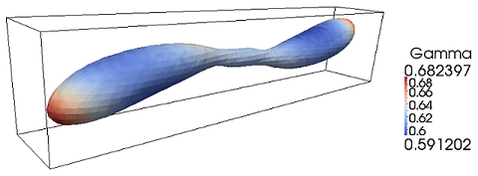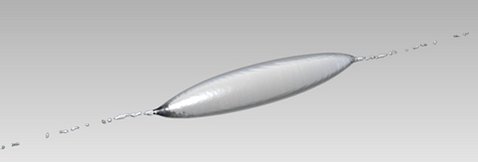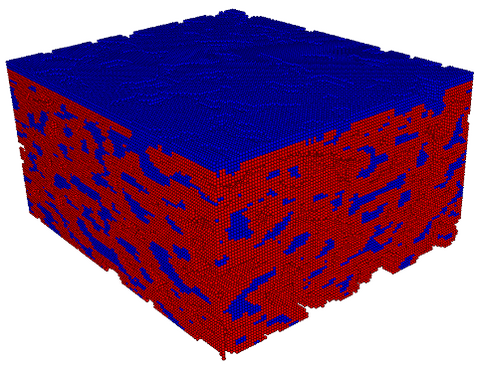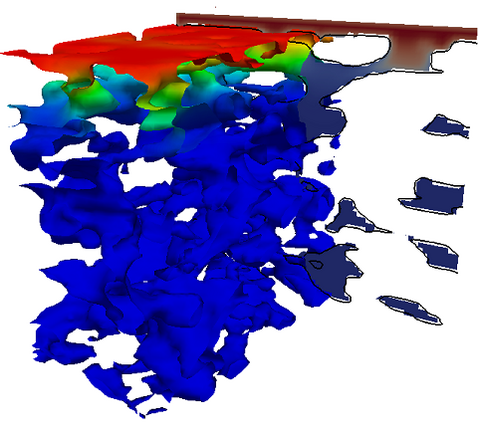Numerical investigation of complex multiphase flows with Lagrangian particle methods




Introduction
We have developed a smoothed particle hydrodynamics (SPH) method to simulate complex multiphase flows with arbitrary interfaces and included a model for surface active agents (surfactants) [1]. Surfactants are modelled in our method with a scalar transport equation that includes bulk diffusion, surface diffusion and transport such as adsorption and desorption between an interface and the adjacent bulk phase. As the surfactant concentration at an interface has an effect on the local surface ten-sion the flow evolution and the surfactant concentration field are coupled leading to very complex physics.
Computational details
Since all particle methods rely on particle-particle interactions their computational effort is strongly in-creased compared to mesh-based simulation tools. Thus, it is even more important to use efficient algo-rithms and to make use of High Performance Comput-ing. We implemented our method in a FORTRAN-Code as a client application using the PPM-Library developed at the ETH Zürich. This platform offers a fully MPI-parallelized “particle-method-environment” for the user that handles all details of communication and is optimized for the usage of thousands of CPU’s.
Drop dynamics in simple shear flow
When drops are exposed to extensional flows (e.g. Couette flow) the viscous stresses at the interface deform the drop and are competing with retarding surface tension forces. Depending on the flow condi-tions and the physical properties of the fluids the drop can either deform to a steady ellipsoid or break-up into two or more droplets. This phenomenon was already studied decades ago and is well understood. When surfactants occur at the drop interface the behaviour can strongly differ from a clean interface. Due to surface concentration gradients the surface tension on the interface can vary locally and induce so-called Marangoni forces that manipulate the break-up process.
Exemplarily we show in Fig. 1 a stretched drop close before breakup where the interface is coloured with the local interface concentration of surfactant. The same experiment for a clean interface results in a similar breakup but much later.
Surfactants do not only change the dynamics of a breakup mode but can also strongly alter the breakup type itself. Fig. 2 shows the so-called tipstreaming phenomenon due to a low diffusive surfactant. Here, the surfactant accumulates mostly at the tips of the stretched drop and the resulting Marangoni-forces suppress the main break-up mode but produce these very thin fluid filaments that leave the drop. This phe-nomenon was first found in experiments and is of high interest as the thickness of these fluid filaments can be much smaller than any flow focusing device can achieve currently [2].
We could reproduce this phenomenon with our model and want to study this effect fundamentally in the future. In the presented simulations we used about 2x106 particles and ran the calculations on the HLRBII with 256 CPU’s for 40 hours.
Multi-species reaction-diffusion in complex geometries
Besides our main interest of simulating surfactant enriched interface dynamics we use our particle method to study transport processes in complex ge-ometries. We have extended our surfactant model for coupled multi-species reaction-diffusion systems and investigate chromium depositioning in fuel cell cath-odes.
The cold combustion in fuel cells is a promising alter-native energy technology that does not produce greenhouse gases. One of the main problems of solid oxide fuel cells (SOFC) that reduces the efficiency dramatically is the chromium poisoning. The current collectors in SOFCs are made of stainless steel that contains chromium. By chemical reaction volatile chromium can migrate into the porous cathode and react with its surface. This effect degrades the effi-ciency strongly and has to be controlled.
As we are interested especially in the impact of sur-face diffusion, we do not simulate an entire fuel cell with an air channel, current collector, anode and cathode but study the species dynamics in a section of the cathode to estimate time scales and the influence of reaction rates and surface diffusion on the distribution of a species in the cathode. Then we can use these results to improve continuous coarse-grid models for porous media and study the depositioning of chromium in a real cathode.
For that purpose we take a pixelmap of a section of a real cathode structure (provided by the Pacific Northwest National Laboratory, Washington, USA) and discretize the pores and the air phase with SPH particles, see Fig. 3. The resolution of the block is 32x32x26, thus a total of 1,048,576 particles is used.
We impose symmetric boundary conditions in x and y direction and prescribe the species concentration at the top layer of the cathode. Besides diffusion in the bulk chromium can react with the surface and diffuse along the interface into the cathode. Then, due to local non-equilibrium chromium can desorb back to the bulk phase much deeper in the structure than bulk diffusion can transport the species in this time-scale. As an example we show the bulk and interface concentration field of chromium in the cathode in Fig. 4.
Analyzing different parameter combinations we found that finite chromium reaction rates can cause high chromium concentrations deep in the cathode even at very small bulk diffusivity. This complex interplay has to be further investigated aiming for a better understanding of this poisoning process in order to develop more efficient cathodes.
On-going Research
A key step in the next period of our project is the vali-dation of our results with high resolution simulations. Consequentially we plan to modify our I/O routines to handle large data produced by the simulations and want to explore the functionality of our program for large number of processors (O(103-104)). Secondly, we want to increase the complexity of the physical models applied in the simulations to detect the domi-nating effects. In the present study of drop breakup we only consider surface diffusion of insoluble surfac-tants, but transport phenomena such as adsorption and coupling with bulk diffusion can be included. For the cathode we want to explore a more complex cou-pled two-species transport model to represent the competitive species dynamics of oxygen and chro-mium and use more realistic boundary conditions such as prescribed flux conditions and concentration dependent reaction rates.